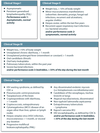HIV Flashcards
How many distinct HIV viruses are there?
Two:
- HIV-1
- HIV-2
What is the most predominant type of HIV virus?
HIV-1
What type of virus is the HIV virus?
Retrovirus
How many RNA chains does the HIV virus have?
Two single chains of RNA
Describe the life-cycle of the HIV virus
- Binding: virus binds to host CD4 receptor molecules via the envelope glycoprotein gp 120 and co-receptors CCR5 and CXCR4.
- Fusion: subsequent conformational change results in the fusion between gp41 and the cell membrane.
- Reverse transcription: entry of the viral capsid followed by uncoating of RNA. DNA copies are made from both RNA templates. DNA polymerase from the host cell leads to formation of dsDNA.
- Integration: virally encoded DNA is inserted into the host genome - Integrase
- Transcription: regulatory proteins control transcription (an RNA molecule is now synthesized from the DNA template).
- Budding: the virus is reassembled (protease - needed for mature virus progeny) in the cytoplasm and budded out from the host cell

What are the 4 distinct strains of HIV?
- Group M - 98% of infections worldwide
- Group N
- Group O
- Group P
What is the general progression of infection in HIV?

Describe the pathogenesis of HIV
- Virus transported by dendritic cells from mucosal surfaces
- GP120 reacts with CD4 and CCR5/CXCR4 -> entry into CD4 T cells, monocytes, macrophages and neural cells
- CD4 +ve cells migrate to lymphoid tissue
- Viral contents becomes integrated into nucleus of cell -> reverse transcription can take place
- As infection progresses - CD4 depletion/impaired function
How can HIV be transmitted?
All fluids
- Sexual intercourse - Semen, cervical secretions
- Mother-to-child
- Contaminated blood, blood products, organ donation
- Contaminated needles (IVDU, Injections, Needle-stick injuries)
Where is HIV-2 most commonly found?
Most parts of WEst Africa
What enzyme integrates viral RNA into host DNA?
Viral integrase
What viral enzymes cleave initial viral proteins into enzymes and building blocks of the virus?
Viral proteases
What is seroconversion?
The time period during which a specific antibody develops and becomes detectable in the blood. After seroconversion has occurred, the disease can be detected in blood tests for the antibody
How soon after initial exposure does seroconversion occur?
2-6 weeks
What are features of HIV seroconversion?
Presents with flu-like syndrome:
- Fever
- Malaise
- Myalgia
- Pharyngitis
- Maculopapular rash
- Lymphdenopathy
- Mucosal ulceration
- Headache/asceptic meningitis - rare
What cells are susceptible to HIV infection?
- CD4+ T cells
- Macrophages
- Monocytes
- Neurons
What follows seroconversion?
Asymptomatic infection, or persistent generalised lymphadenopathy
How long can asymptomatic infection last for following seroconversion?
Can last for years
What defines the first clinical stage of HIV infection?
Asymptomatic infection or PGL

What features define clinical stage II of HIV infection?
- Weight loss < 10%
- Minor cutaneous manifestations
- Herpes zoster in last 5 years
- Recurrent URTI
- Performance scale 1 - normal activity

What features define clinical stage III HIV infection?
- Weight loss > 10%
- Unexplained chronic diarrhoea > 1 month
- Unexplained prolonged fever > 1 month
- Oral candidiasis
- Oral hairy leukoplakia
- Pulmonary TB within past year
- Several bacterial infections
- Performace scale 3 - bedridden <50% of day

What features suggest clinical stage IV HIV infection (AIDS defining illnesses)?
- HIV wasting synrome
- PCP
- Toxoplasmosis of the brain
- Cryptosporidiosis with diarrhoea > 1 month
- CMV of organ other than liver, spleen or lymph nodes
- HSV > 1 month
- Progressive multifocal leukoencephalopathy
- Any disseminated endemic mycosis
- Candidiasis of oesophagus/trachea/bronchi/lung
- Atypical disseminated TB
- Extrapulmonary TB
- Kapose’s sarcoma
- HIV encephalopathy
- Performace scale 4 - bedridden > 50% day in last month

What respiratory conditions are regarded as AIDS defining illnesses?
- TB
- Pneumocystis

What proportion of individuals develop persistent generalised lymphadenopathy?
30%
What neurological conditions would you consider doing HIV testing in?
AIDS defining illnesses, plus:
- Aseptic meningitis/encephalitis
- Cerebral abscess
- SOL of unknown cause
- Guillain-Barre syndrome
- Transverse myelitis
- Unexplained Peripheral neuropathy
- Lecuoencephalopathy

What dermatological conditions are regarded as AIDS defining illnesses?
Kaposi’s sarcoma

What is persistent generalised lymphadenopathy?
Lymph nodes >1cm in diameter at >/= 2 extra-inguinal sites, persisting for > 3 months
What GI disorders are regarded as AIDs defining illnesses?
Persistent cryptosporidiosis

What GI conditions would you consider offering an HIV test in?
- Persistent cryptosporidiosis
- Oral candidiasis
- Oral hairy leukoplacia
- Chronic diarrhoea of unknown cause
- Weight loss of unknown cause

What oncological problems are regarded as AIDs defining illnesses?
Non-Hodgkin’s Lymphoma

What is Kaposi’s Sarcoma?
A cancer that causes patches of abnormal tissue to grow under the skin, in the lining of the mouth, nose, and throat, in lymph nodes, or in other organs

What is the following?

Oral hairy leucoplakia - a white patch on the side of the tongue with a corrugated or hairy appearance.
What is the following?

Oral candidiasis
What eye disease is regarded as an AIDs defining illness?
CMV retinitis

What neurological conditions are regareded as AIDS defining illnesses?
- Cerebral toxoplasmosis
- Primary cerebral lymphoma
- Cryptococcal meningitis
- Progressive multifocal leucoencephalopathy
What is important to remember when trying to determine if someone has HIV with regards to test results?
Remember the diagnostic window - time during which diagnostic markers are not detectable

What dermatological conditions would you consider doing HIV testing in?
- Kaposi’s Sarcoma
- Severe/intractable seborrhoeic dermatitis
- Severe/reclacitrant psoriasis
- Recurrent/multidermatomal HSV
How does cerebral toxoplasmosis present?
- Confusion
- Seizures
- Fever
- Headache
- Drowsiness/Coma
- Signs of braainstem/spinal cord problems






